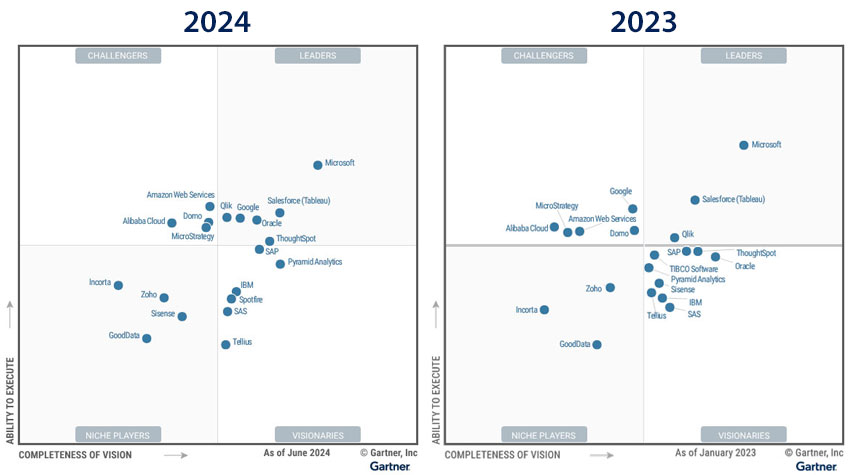The Gartner Magic Quadrant for Analytics and Business Intelligence Platforms 2024 is here.
On its release, the report sheds light on a space undergoing significant change.
After all, with trends ranging from data storytelling and governance to advanced analytics and augmented AI, there’s a lot happening in the analytics and business intelligence (ABI) market.
Thankfully, Gartner offers a comprehensive overview of that market and its most prominent global players.
Below is a quick-fire review of each provider’s performance after an essential outline of how Gartner defines analytics and business intelligence platforms.
→ THE 2025 Edition: Check out CX Today’s coverage of the latest Gartner Magic Quadrant for ABI Platforms.
The Definition of Analytics and Business Intelligence Platforms
According to Gartner, an analytics and business intelligence platform enables brands to “model, analyze, and share data”.
As organizations do so, they may interact with their data, create custom measures from it, and visualize insights.
Increasingly, these platforms are becoming available to non-technical users, who can pull insights relevant to their objectives and workflows.
Yet, to support such use cases, the solution must blend modeled and non-modeled data to ensure the necessary insight generation.
However, that’s only a fraction of what an analytics and business intelligence – or ABI – platform provides brands.
Recognizing this, Gartner names 12 mandatory and common features of such a platform. These are:
- Data visualization
- Governance
- Reporting
- Analytics Catalog
- Data preparation
- Data science integration
- Automated insights
- Metrics layer
- Data storytelling
- Natural language query (NLQ)
- Collaboration
- Composability
The 20 ABI platform providers below innovate around these areas to differentiate.
In doing so, they’ve established a significant market presence and popular offerings.
After evaluating each, Gartner separated them into four categories: Leaders, Challengers, Visionaries, and Niche Players. Here’s how they performed.

The 2024 Analytics and Business Intelligence Platforms Magic Quadrant Leaders
Leaders in the Magic Quadrant understand their core product capabilities, make them easily comprehensible, and offer an “attractive” pricing model. Moreover, they demonstrate a commitment to customer success, a fast innovation cycle, and a robust roadmap. This year’s Leaders are:
- Microsoft
- Salesforce (Tableau)
- Oracle
- ThoughtSpot
- Qlik
Microsoft
Microsoft “dominates” the business intelligence space in its user adoption, according to Gartner. Over the past four years, its success has accelerated, with the analyst crediting Microsoft’s “strong” grouping of ecosystem, functionality, and price. Alongside this, Microsoft benefits from its product ambition and broader Power portfolio, which helps automate customer flows, so insight triggers actions. Finally, Gartner highlights the addition of Copilot for Power BI as a strength, enthused by how GenAI may transform the report creation process.
Salesforce (Tableau)
Salesforce has pulled Tableau into its core Einstein 1 Platform, enabling a robust growth rate of 16 percent, which is much higher than many of the other vendors included in the study. According to Gartner, that demonstrates its “strong” corporate viability and is one of Salesforce’s core strengths. Others include its dedicated leadership teams and composable analytics. The latter catches the eye, as Salesforce has re-engineered the architecture to be more agile, facilitating a quicker release cycle and innovations like Tableau Pulse, which enables a generative analytics experience.
Oracle
The Oracle Analytics Cloud benefits from the vendor’s suite-first approach. That structure allows Oracle-centric customers to embed decision workflows within various business applications and workflows. These empower employees with data-driven recommendations when and where they make the most impact. That flexibility to enable decision-centric business apps is a significant plus, alongside its enterprise cloud ecosystem, data management, and data integration capabilities. Oracle’s pre-built data pipelines and AI models exemplify the latter.
ThoughtSpot
ThoughtSpot impressed Gartner with its “visionary” GenAI product strategy. That strategy embeds in its automated insights, data storytelling, and new reasoning capabilities. The latter enables personalized user Q&A suggestions. In highlighting this strength, Gartner notes how ThoughtSpot’s AI is “self-learning” and enabled by GPT-4 and Gemini. Other strengths include its modularity for the modern data stack and track record for delivering successful customer deployments, experiences, and support – with the analyst citing verified customers on its Peer Insights platform.
Like Salesforce, Google is gaining market momentum. Indeed, Gartner has received many queries regarding its Looker platform over the past year. Looker’s large social network following is one potential driver. Yet, after integrating Looker Studio with LookML, Google now also attracts buyers with a unified offering for centrally governed analytics and self-service. Market momentum aside, the tech giant excels in its “strong” data and analytics stack and “excellent” composability. Such composability enables headless BI integration with other open-source data technologies.
Qlik
Qlik has made numerous acquisitions over the last five years to bolster its Qlik Cloud Analytics platform. One of the most significant is its Talend roll-up to advance its data foundation. That – alongside its evolving data science and LLM approach – enabled end-to-end analytics. Gartner spotlights that analytics capability as a core strength, alongside its cloud-/application-agnostic design and renewed market recognition. Again, its M&A strategy has helped, spurring Qlik on to become a “top five” vendor for business intelligence and data integration solutions.
The 2024 Analytics and Business Intelligence Platforms Magic Quadrant Challengers
Challengers in the Magic Quadrant are well-positioned to succeed within the market, with a record of successful – albeit sometimes “limited” – deployments. However, they may lag Leaders in product co-ordination, sector-specific innovation, and overall vision. This year’s Challengers are:
- Amazon Web Services (AWS)
- Domo
- MicroStrategy
- Alibaba Cloud
Amazon Web Services (AWS)
Amazon QuickSight is often leveraged by broader AWS ecosystem buyers. In part, that’s perhaps due to convenience, but also its competitive pricing. Indeed, a license starts at $3 per user per month, with guardrails to prevent overprovisioning. Gartner highlights this pricing model as a central strength of the platform, alongside its integrated global cloud service and serverless architecture. That architecture supports high scalability and performance. Yet, Gartner cautions that the offering is limited to the AWS cloud and – for governance – relies on separately licensed tools.
Domo
Domo takes a use-case-first approach in developing its platform, building a highly proficient multi-persona support strategy that addresses key stakeholders from business analysts to data scientists. Other highlighted strengths include Domo’s Magic ETL tool that enables “outstanding” data preparation capabilities, its new consumption model, and its bring-your-own AI proposition. The latter allows businesses to deploy third-party LLMs or build and train their own. However, Domo’s limited broader ecosystem beyond BI has hampered its innovation and growth opportunities.
MicroStrategy
The Magic Quadrant describes the launch of MicroStrategy AI – a native suite of GenAI tools – as a “significant leap forward” for the vendor. Indeed, it allowed MicroStrategy to deliver a “GenAI experience” that empowers users with unique intelligent automation capabilities. These users may also harness bots for fast insight and to remove the dashboard dependency. Gartner isolates this “experience” as a strength alongside MicroStrategy’s open platform, enterprise reporting, and data governance. Yet, it cautions to its augmented analytics and limited surrounding app ecosystem.
Alibaba Cloud
Quick BI is available on Alibaba Cloud through packages that are customizable by function. As such, its pricing model has significant flex and positions the vendor to be competitive. Alibaba Cloud’s focus on composable analytics and building a data literacy program are also significant drawers, as Gartner pinpoints. Nevertheless, Alibaba is very much pegged to China, and its constrained geographical presence has stalled its market momentum. Moreover, with limited investment and a “complex competition environment”, don’t expect that to change anytime soon.
The 2024 Analytics and Business Intelligence Platforms Magic Quadrant Visionaries
Visionaries in the Magic Quadrant offer a differentiated vision for the future ABI platform, delivering deep functionality in specific areas. Yet, they typically trail leaders in their broader capabilities. Alternatively, they may lack scale, CX prowess, or sales proficiency. This year’s Visionaries are:
- SAP
- Pyramid Analytics
- IBM
- Spotfire
- SAS
- Tellius
SAP
SAP Analytics Cloud lays over the applications within the vendor’s broader applications suite, with pre-defined data integrations and models. These augment SAP business processes and tap non-SAP data for context-enriched decision-making. The vendor further supports such decision-making with features such as what-if modeling, influencer analysis, and predictive simulations. Gartner gives plaudits to all this, alongside its analytics accelerators for SAP business apps. Yet, the analyst cautions that SAP doesn’t stand out in any one use case and has narrow adoption outside its ecosystem.
Pyramid Analytics
Pyramid Analytics provides businesses with multiple data preparation experiences for analytics, allowing the vendor to meet its customers where they are on their ABI journey. In addition, the provider offers multiple embedding options and analytics personas, with its deep data science and machine learning capabilities supporting the latter. Many of those are available through its Data Science Workbench. While Gartner shares much more on these strengths, it warns that Pyramid Analytics doesn’t provide custom native connectors to competitive solutions and has a “limited” community.
IBM
IBM Cognos Analytics offers rich visuals, narrative insights, and smart recommendations. Yet, Gartner focuses on its vision as its central differentiator. Indeed, it shows exceptional vision in its analytic catalog and decision intelligence. Focusing on the former, IBM has developed a suite of solutions for various personas, centralized within a single Content Hub. That makes ABI more management. Gartner commends this vision alongside its enterprise content distribution capacity. However, it cautions that IBM lags on data preparation features and prioritizes IBM Cloud deployments.
Spotfire
Spotfire is available on-premise and fully cloud-agnostic. In other words, it offers the same features, no matter the cloud environment it’s implemented within. Gartner recognizes this as a major plus alongside its sector-specific applications and multi-persona-centric platform. The former helps differentiate the vendor with pre-built solution accelerators for use cases across various verticals. For instance, it offers continuous supply chain and healthcare interoperability accelerators. However, Gartner suggests that the vendor should broaden its vertical focus and warns of high license costs.
SAS
SAS Viya has “AI at the core”. For instance, AI and machine learning are baked into its data preparation and analytics creation automations, encouraging enhanced performance through the data & analytics lifecycle. That AI-centric approach garners positive recognition from Gartner, in addition to SAS’s flexible open architecture and the shared spaces within the platform that encourage collaboration across personas. Nevertheless the analyst suggests that the vendor offers little transparency in its pricing structure and interoperability with Microsoft 365 competitors.
Tellius
Tellius divides insights into “How?”, “What?”, and “Why?” interfaces. That approach is novel and pairs well with the vendor’s strengths in delivering automated insights and NLQ. Indeed, Gartner brands Tellius as an NLQ-first platform, with “strong” functionality in auto-suggestions, Q&A, and type ahead. That’s a core strength alongside the vendor’s industry-specific focus, performance, and scalability, with Tellius leveraging a microservices-based architecture to flaunt the latter. Yet, it has product gaps – as per Gartner – and its infant developer communities only widen this issue.
The 2024 Analytics and Business Intelligence Platforms Magic Quadrant Niche Players
Niche Players in the Magic Quadrant often meet customer expectations in particular domains or across different use cases. They may also slip well into specific cloud stacks. However, a limited reach, innovation curve, and/or vision can derail their market competitiveness. This year’s Niche Players are:
- Sisense
- Zoho
- Incorta
- GoodData
Sisense
Sisense invests significantly in embedded capabilities, most recently launching Compose SDK, a code-first development kit. The offering allows the vendor to increase its composability and deliver persona-driven analytics through multimodal channels. Gartner notes that capability is a central strength of the Sisense Fusion platform, in addition to its DevOps-first philosophy and “analytics discoverability.” The latter is evident in its “robust” UX features and connections to third-party cataloging platforms. However, Gartner suggests its metrics layer lacks accessibility.
Zoho
Zoho offers a comprehensive library of pre-built dashboards and reports for specific industries. It then couples this with its data blending functionality to integrate insights across numerous line of business (LOB) apps. As a result, companies may develop an end-to-end LOB analytics strategy. Gartner values such an opportunity by spotlighting it as a core strength alongside Zoho’s composable analytics and the supportive might of its vast ecosystem. Nevertheless, the analyst highlights a product capability gap and “subdued” market momentum.
Incorta
Agile is perhaps an overused word within the ABI and broader CX space. However, Incorta does offer truly agile operation reporting and high-level metrics, which brands can dig deeper into. Moreover, customers can achieve this without long data warehousing and ETL efforts – as per Gartner. The analyst recognizes this as one of three core strengths alongside its high appeal to low-maturity customers and the openness of its platform. It does, however, caution that the vendor lacks augmented consumer functionality and faces stiff competition from packaged analytics apps.
GoodData
GoodData finds success with more niche ABI use cases, such as those where customers wish to build an integrated metrics store as a “universal semantic layer”. Its headless approach enables such use cases, and that headless vision earns kudos from Gartner – as does its compossibility-first focus and the availability of third-party resources across its cloud platforms. Yet, Gartner also cautions that the platform is constrained to mature buyers and that more conventional ABI deployments are limited. The lagging adoption of the headless metrics layers – which Gartner commended – is also a concern.
How Do the Results Compare to 2023?
ThoughtSpot, Oracle, and Google have joined the Leader quadrant this year.
In doing so, they seem to have closed the gap on Microsoft and Salesforce. However, these are still the two vendors closest to that “magical” top-right corner of the quadrant.
The only other shift sees Sisense slip from a Visionary to a Niche Player.

Meanwhile, 19 of the 20 included vendors are the same as last year, with Spotfire replacing TIBCO Software.
Although, Gartner gives honorable mentions to other providers, including Aible, iGenius, and Yellowfin.
Deep dive into other CX-related Magic Quadrant rundowns by reading the following articles:
- Gartner Magic Quadrant for Customer Data Platforms 2024
- Gartner Magic Quadrant for Customer Data Platforms 2024
- Gartner Magic Quadrant for Cloud ERP for Service-Centric Enterprises 2023







